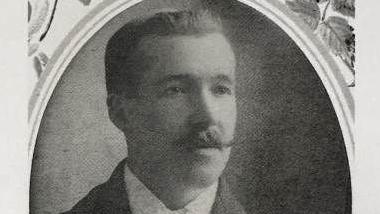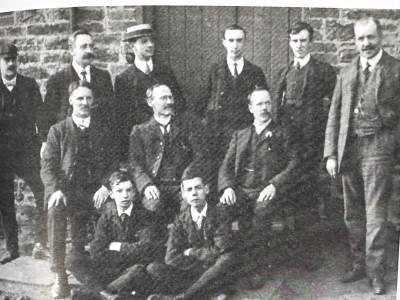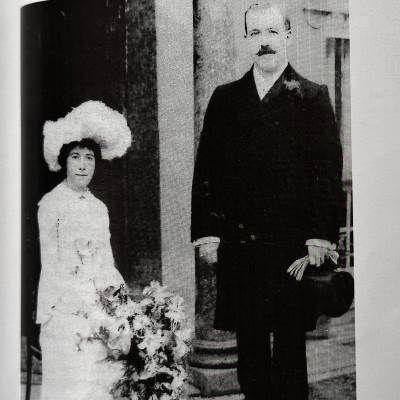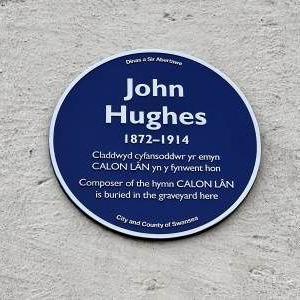The unsung hero of 'second Welsh anthem' Calon Lân

John Hughes composed the tune to Calon Lân
- Published
Often described as Wales' second national anthem, Calon Lân reverberates around the stadium whenever Wales are playing in the Six Nations.
Yet ask the thousands of rugby fans “who wrote it?” and many will only know who wrote the words.
That accolade goes to celebrated Swansea poet and drinker Daniel James - or to give him his bardic name - Gwyrosydd.
The instantly recognisable tune was however written by someone who could not be more different - clean-living, chapel-going accountant John Hughes.
Who was John Hughes?
Born in Pembrokeshire in February 1872, John Hughes' family moved to Swansea in search of work when he was a toddler.
Despite leaving school at the age of 12, he rose through the ranks of Morriston’s Duffryn Steel and Tinplate Works from office boy, to overseas consultant, and eventually becoming company accountant and general manager.
He is said to have spoken four languages, and negotiated contracts in Canada, the US, Russia and Spain.

John Hughes was part of the staff at Duffryn Steel and Tinplate Works
Geraint Williams, chairman of the Calon Lân Society, said composing music was more than just a hobby for this career man.
"It tells you all you need to know about John Hughes really, he was a diligent worker and a family man to his widowed mother, wife and three daughters, and enjoyed nothing more than taking them all on paddle steamer trips over to Ilfracombe.
"He took the pledge of abstinence aged 16, and chapel was at the very heart of his social, moral and philosophical life, so composing hymns wasn’t just a pastime, he saw it as his duty to the chapel congregation."

John Hughes with wife Mary Ann on their wedding day
Daniel James, on the other hand, was an iron puddler and boozer who would sell his poems for pints in the King’s Head pub, Llangyfelach.
Local legend has it that Calon Lan itself was scribbled on the back of a cigarette packet.
James has had not one, but two schools named in his honour: Gwyrosydd Primary School after his bardic name, and the now-closed Daniel James Comprehensive School in Swansea.
So why is his story so enduring, while John Hughes has faded into obscurity? Mr Williams believes he knows the answer.
"Well, it’s obvious really: everyone loves a bad boy… even in chapel.
"Daniel James’ story is so much more exciting, isn’t it? Comparisons are often drawn with him and Dylan Thomas; personally I think James was a far nicer person than Thomas, but there are definitely similarities in their writing.
"Stories about James were easy to come by, but sadly no-one writes legends about upstanding, (less kind people may say boring) pillars of the community like John Hughes."

Commemorative plaque at Caersalem Newydd Chapel, Tre-boeth, Swansea
Accounts vary as to how exactly James' lyrics and Hughes' melody were eventually married up.
James' words were penned in 1891, and originally set to different music by his friend Thomas Bedford Richards.
Hughes composed his interpretation almost a decade later.
The romanticised version of the tale has it that James waited outside Hughes’ house one Sunday afternoon, begging him to come up with a new tune for Calon Lan; Hughes created it while he ate his tea, and returned it to James before evensong.
The more prosaic explanation is that the lyrics had already been in circulation for some time, and that Hughes reimagined them for Swansea’s turn of the century celebrations in 1900.
"I think the simpler story is probably more correct. Whilst James and Hughes had both worked at Duffryn, James was 24 years older and had already moved to Blaengarw by the time he wrote Calon Lan."
What is not in dispute is that when Hughes first presented the score to John Evans, organist at Dinas Noddfa Chapel, Landore, Evans remarked prophetically: "This will go all over the world."
Today Calon Lan has been translated into at least six languages, and is sung in more than 20 countries, from Wales to Fiji and Singapore.
Hughes died of a brain haemorrhage aged 42 in June 1915.
He is buried with his parents in a family plot at Caersalem Newydd Baptist Chapel.
Related topics
- Published16 September 2023

- Published12 January 2013
- Published8 June 2015